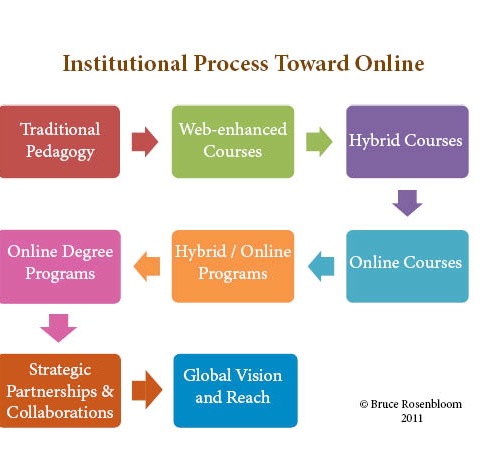In Part 1 on this topic, I discussed the evolution of hybrid online learning from traditional pedagogy to the point where hybrid/online courses are first offered (as illustrated in the diagram below). This process is characterized by instructors willing to take chances and experiment with new technologies and modes of teaching, even prior to official sanction at their campuses. However, once this process reaches a critical mass and the “early adopters” have led the way, then more institutional support and oversight begin. Faculty development, student support, faculty governance issues, and assessment of hybrid/online courses become an institutional priority.
This post will delve into the next steps in this evolution, namely the planning of hybrid/online programs. In my estimation, CUNY is at this critical junction in the evolution of online, where campus leaders will soon consider, at first individually, and then collectively, whether disparate hybrid and online courses can eventually morph into programs and even entire degree programs. But why would such an evolution be desirable?
Let’s examine a typical scenario. Department X in a college has several professors who are either currently teaching hybrid or fully online classes, and several more who are interested in doing so. The department chair may even be open to these new modes of teaching. There would be several advantages to reviewing an entire program of study in terms of offering hybrid and online courses throughout that curriculum. These advantages would include:
- Accelerate time to degree by current students
- Create synergies among interested faculty to support each other
- Allow for a program review in terms of determining the best courses to be offered in either online or hybrid mode
- Potentially reduce bottlenecks for particular in-demand courses
- Allow greater flexibility in scheduling and classroom utilization, and
- Increase access and convenience for students and instructors.
These and other compelling reasons may be cited for a particular department, school or college to consider when taking the next evolutionary step toward online, namely offering an array of hybrid/online course options for students in particular programs. At the point when students demand these options and faculty resistance to hybrid/online learning is lessened, then, I believe, we will see a greater adoption of hybrid/online programs throughout CUNY.
Fully online degree programs pose additional hurdles. The state (New York in this instance) must approve all new degree programs, regardless of mode of teaching. That process takes time and requires a laborious amount of paperwork and program justification prior to approval. Currently, only the School of Professional Studies has fully online programs within CUNY, although John Jay College is also in the process of planning such programming in the not-too-distant future. It should be noted that the CUNY Online BA program has expanded to include other degree areas like Psychology (starting Spring 2012), Sociology, and even a masters program in Business. I believe the success of these fully online programs will spur interest at other CUNY campuses.
At this juncture in CUNY’s online development, some senior campus leaders will get more involved with guiding their respective colleges exploring hybrid/online. I anticipate several hybrid/online pilot programs throughout CUNY in the upcoming years, initiated at the campus level. For example, I have heard that several CUNY nursing programs are actively exploring how their students may benefit from non-clinical online courses. These efforts will invariably encounter resistance from some traditional campus bastions, yet the trend toward hybrid/online programs will be largely unstoppable once the benefits to the institution, faculty and students become obvious.
In Part 3 on this topic, I will cover the next phases in the institutional process toward online — that of strategic alliances/partnerships with the ensuing global vision and reach. These stages are seen in more mature online programs at institutions with a longer track record in online learning. I suspect that at CUNY, these last stages in my diagram are several years away from realization.



